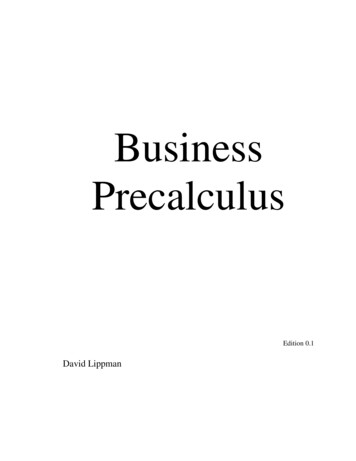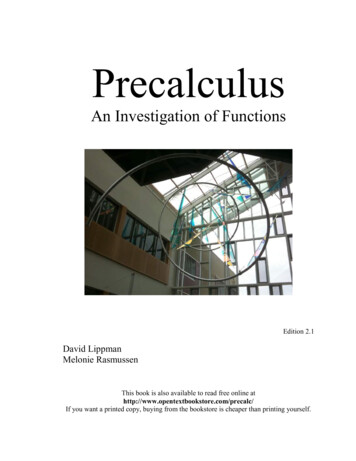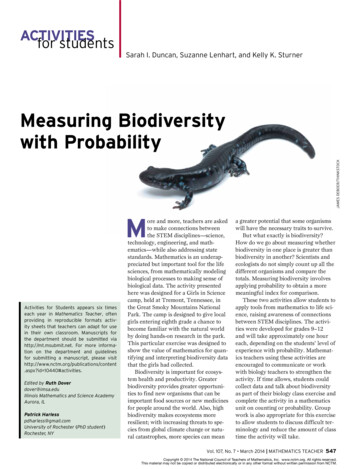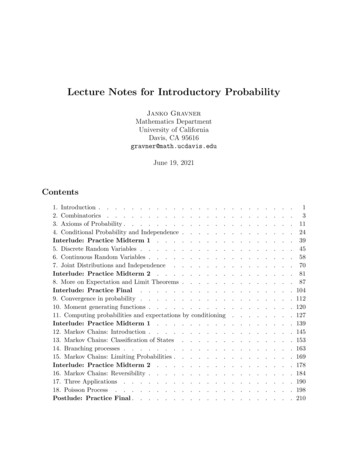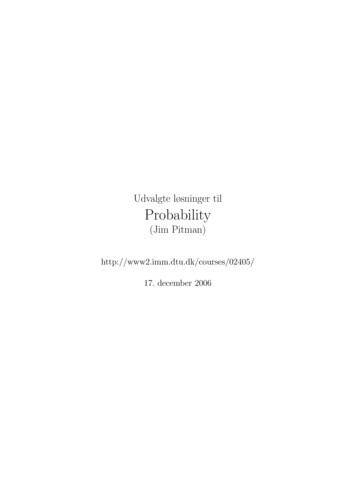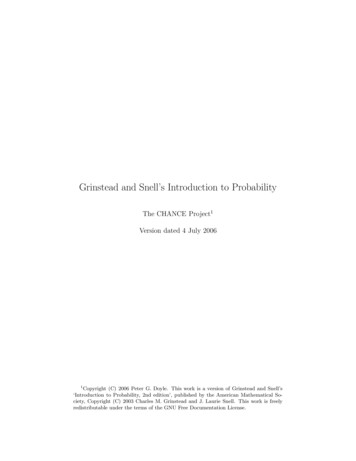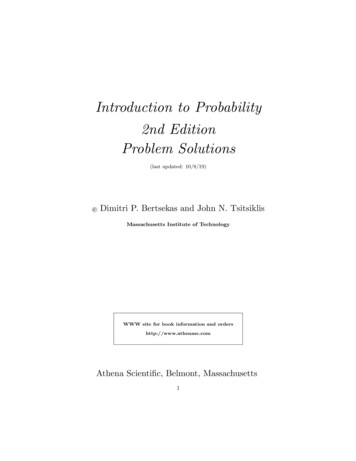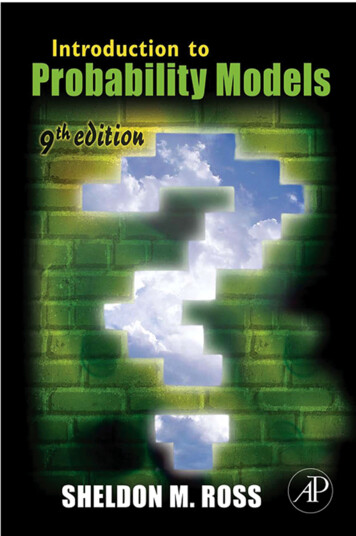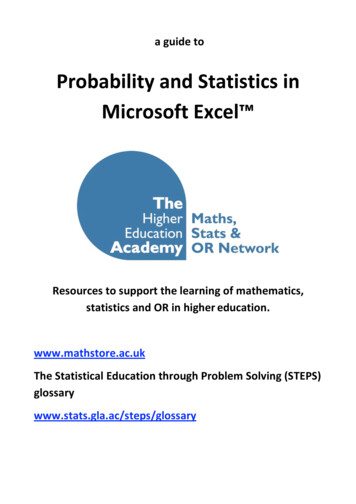
Transcription
Probability 279ProbabilityIntroductionThe probability of a specified event is the chance or likelihood that it will occur. There areseveral ways of viewing probability. One would be experimental in nature, where werepeatedly conduct an experiment. Suppose we flipped a coin over and over and over againand it came up heads about half of the time; we would expect that in the future whenever weflipped the coin it would turn up heads about half of the time. When a weather reporter says“there is a 10% chance of rain tomorrow,” she is basing that on prior evidence; that out of alldays with similar weather patterns, it has rained on 1 out of 10 of those days.Another view would be subjective in nature, in other words an educated guess. If someoneasked you the probability that the Seattle Mariners would win their next baseball game, itwould be impossible to conduct an experiment where the same two teams played each otherrepeatedly, each time with the same starting lineup and starting pitchers, each starting at thesame time of day on the same field under the precisely the same conditions. Since there areso many variables to take into account, someone familiar with baseball and with the twoteams involved might make an educated guess that there is a 75% chance they will win thegame; that is, if the same two teams were to play each other repeatedly under identicalconditions, the Mariners would win about three out of every four games. But this is just aguess, with no way to verify its accuracy, and depending upon how educated the educatedguesser is, a subjective probability may not be worth very much.We will return to the experimental and subjective probabilities from time to time, but in thiscourse we will mostly be concerned with theoretical probability, which is defined asfollows: Suppose there is a situation with n equally likely possible outcomes and that m ofthose n outcomes correspond to a particular event; then the probability of that event ismdefined as.nBasic ConceptsIf you roll a die, pick a card from deck of playing cards, or randomly select a person andobserve their hair color, we are executing an experiment or procedure. In probability, welook at the likelihood of different outcomes. We begin with some terminology.Events and OutcomesThe result of an experiment is called an outcome.An event is any particular outcome or group of outcomes.A simple event is an event that cannot be broken down furtherThe sample space is the set of all possible simple events. David LippmanCreative Commons BY-SA
280Example 1If we roll a standard 6-sided die, describe the sample space and some simple events.The sample space is the set of all possible simple events: {1,2,3,4,5,6}Some examples of simple events:We roll a 1We roll a 5Some compound events:We roll a number bigger than 4We roll an even numberTwo diceOne dieBasic ProbabilityGiven that all outcomes are equally likely, we can compute the probability of an eventE using this formula:Number of outcomes correspond ing to the event EP( E ) Total number of equally - likely outcomesExample 2If we roll a 6-sided die, calculatea) P(rolling a 1)b) P(rolling a number bigger than 4)Recall that the sample space is {1,2,3,4,5,6}a) There is one outcome corresponding to “rolling a 1”, so the probability isb) There are two outcomes bigger than a 4, so the probability is162 1 6 3Probabilities are essentially fractions, and can be reduced to lower terms like fractions.Example 3Let's say you have a bag with 20 cherries, 14 sweet and 6 sour. If you pick a cherry atrandom, what is the probability that it will be sweet?There are 20 possible cherries that could be picked, so the number of possible outcomes is20. Of these 20 possible outcomes, 14 are favorable (sweet), so the probability that the cherry147 .will be sweet is20 10
Probability 281There is one potential complication to this example, however. It must be assumed that theprobability of picking any of the cherries is the same as the probability of picking any other.This wouldn't be true if (let us imagine) the sweet cherries are smaller than the sour ones.(The sour cherries would come to hand more readily when you sampled from the bag.) Let uskeep in mind, therefore, that when we assess probabilities in terms of the ratio of favorable toall potential cases, we rely heavily on the assumption of equal probability for all outcomes.Try it Now 1At some random moment, you look at your clock and note the minutes reading.a. What is probability the minutes reading is 15?b. What is the probability the minutes reading is 15 or less?CardsA standard deck of 52 playing cards consists of four suits (hearts, spades, diamondsand clubs). Spades and clubs are black while hearts and diamonds are red. Each suitcontains 13 cards, each of a different rank: an Ace (which in many games functions asboth a low card and a high card), cards numbered 2 through 10, a Jack, a Queen and aKing.Example 4Compute the probability of randomly drawing one card from a deck and getting an Ace.There are 52 cards in the deck and 4 Aces so P ( Ace) 41 0.076952 13We can also think of probabilities as percents: There is a 7.69% chance that a randomlyselected card will be an Ace.Notice that the smallest possible probability is 0 – if there are no outcomes that correspondwith the event. The largest possible probability is 1 – if all possible outcomes correspondwith the event.Certain and Impossible eventsAn impossible event has a probability of 0.A certain event has a probability of 1.The probability of any event must be 0 P ( E ) 1In the course of this chapter, if you compute a probability and get an answer that is negativeor greater than 1, you have made a mistake and should check your work.
282Working with EventsComplementary EventsNow let us examine the probability that an event does not happen. As in the previous section,consider the situation of rolling a six-sided die and first compute the probability of rolling asix: the answer is P(six) 1/6. Now consider the probability that we do not roll a six: there5are 5 outcomes that are not a six, so the answer is P(not a six) . Notice that61 5 6P (six ) P (not a six ) 16 6 6This is not a coincidence. Consider a generic situation with n possible outcomes and anevent E that corresponds to m of these outcomes. Then the remaining n - m outcomescorrespond to E not happening, thusn m n mmP (not E ) 1 1 P( E )nn nnComplement of an EventThe complement of an event is the event “E doesn’t happen”The notation E is used for the complement of event E.We can compute the probability of the complement using P ( E ) 1 P( E )Notice also that P( E ) 1 P ( E )Example 5If you pull a random card from a deck of playing cards, what is the probability it is not aheart?13 1 .52 4The probability of not drawing a heart is the complement:1 3P (not heart ) 1 P (heart ) 1 4 4There are 13 hearts in the deck, so P ( heart ) Probability of two independent eventsExample 6Suppose we flipped a coin and rolled a die, and wanted to know the probability of getting ahead on the coin and a 6 on the die.We could list all possible outcomes: {H1,H2,H3,H4,H5,H6,T1,T2,T3,T4,T5,T6}.
Probability 283Notice there are 2 · 6 12 total outcomes. Out of these, only 1 is the desired outcome, so the1probability is.12The prior example was looking at two independent events.Independent EventsEvents A and B are independent events if the probability of Event B occurring is thesame whether or not Event A occurs.Example 7Are these events independent?a) A fair coin is tossed two times. The two events are (1) first toss is a head and (2) secondtoss is a head.b) The two events (1) "It will rain tomorrow in Houston" and (2) "It will rain tomorrow inGalveston” (a city near Houston).c) You draw a card from a deck, then draw a second card without replacing the first.a) The probability that a head comes up on the second toss is 1/2 regardless of whether or nota head came up on the first toss, so these events are independent.b) These events are not independent because it is more likely that it will rain in Galveston ondays it rains in Houston than on days it does not.c) The probability of the second card being red depends on whether the first card is red ornot, so these events are not independent.When two events are independent, the probability of both occurring is the product of theprobabilities of the individual events.P(A and B) for independent eventsIf events A and B are independent, then the probability of both A and B occurring isP(A and B) P(A) · P(B)where P(A and B) is the probability of events A and B both occurring, P(A) is theprobability of event A occurring, and P(B) is the probability of event B occurringIf you look back at the coin and die example from earlier, you can see how the number ofoutcomes of the first event multiplied by the number of outcomes in the second eventmultiplied to equal the total number of possible outcomes in the combined event.
284Example 8In your drawer you have 10 pairs of socks, 6 of which are white, and 7 tee shirts, 3 of whichare white. If you randomly reach in and pull out a pair of socks and a tee shirt, what is theprobability both are white?The probability of choosing a white pair of socks is6.103.76 3 189 The probability of both being white is10 7 70 35The probability of choosing a white tee shirt isTry it Now 2A card is pulled a deck of cards and noted. The card is then replaced, the deck is shuffled,and a second card is removed and noted. What is the probability that both cards are Aces?The previous examples looked at the probability of both events occurring. Now we will lookat the probability of either event occurring.Example 9Suppose we flipped a coin and rolled a die, and wanted to know the probability of getting ahead on the coin or a 6 on the die.Here, there are still 12 possible outcomes: {H1,H2,H3,H4,H5,H6,T1,T2,T3,T4,T5,T6}By simply counting, we can see that 7 of the outcomes have a head on the coin or a 6 on thedie or both – we use or inclusively here (these 7 outcomes are H1, H2, H3, H4, H5, H6, T6),7so the probability is. How could we have found this from the individual probabilities?1211of these outcomes have a head, andof these outcomes have a 6261 1 628 , which is not the correct probability.on the die. If we add these, 2 6 12 12 12Looking at the outcomes we can see why: the outcome H6 would have been counted twice,1since it contains both a head and a 6; the probability of both a head and rolling a 6 is.12As we would expect,If we subtract out this double count, we have the correct probability:8 17 .12 12 12
Probability 285P(A or B)The probability of either A or B occurring (or both) isP(A or B) P(A) P(B) – P(A and B)Example 10Suppose we draw one card from a standard deck. What is the probability that we get a Queenor a King?There are 4 Queens and 4 Kings in the deck, hence 8 outcomes corresponding to a Queen orKing out of 52 possible outcomes. Thus the probability of drawing a Queen or a King is:8P(King or Queen ) 52Note that in this case, there are no cards that are both a Queen and a King, soP(King and Queen ) 0 . Using our probability rule, we could have said:448P(King or Queen ) P (King ) P(Queen ) P (King and Queen ) 0 52 5252In the last example, the events were mutually exclusive, so P(A or B) P(A) P(B).Example 11Suppose we draw one card from a standard deck. What is the probability that we get a redcard or a King?26524There are four kings, so P ( King ) 52Half the cards are red, so P (red) There are two red kings, so P (Red and King ) 252We can then calculateP (Red or King ) P (Red ) P (King ) P (Red and King ) 26 42 28 52 52 52 52Try it Now 3In your drawer you have 10 pairs of socks, 6 of which are white, and 7 tee shirts, 3 of whichare white. If you reach in and randomly grab a pair of socks and a tee shirt, what theprobability at least one is white?
286Example 12The table below shows the number of survey subjects who have received and not received aspeeding ticket in the last year, and the color of their car. Find the probability that arandomly chosen person:a) Has a red car and got a speeding ticketb) Has a red car or got a speeding ticket.Speeding No speeding TotalticketticketRed car15135150Not red car 45470515Total60605665We can see that 15 people of the 665 surveyed had both a red car and got a speeding ticket,15 0.0226 .so the probability is665Notice that having a red car and getting a speeding ticket are not independent events, so theprobability of both of them occurring is not simply the product of probabilities of each oneoccurring.We could answer this question by simply adding up the numbers: 15 people with red carsand speeding tickets 135 with red cars but no ticket 45 with a ticket but no red car 195195 0.2932 .people. So the probability is665We also could have found this probability by:P(had a red car) P(got a speeding ticket) – P(had a red car and got a speeding ticket)150 6015195 .665 665 665 665Conditional ProbabilityOften it is required to compute the probability of an event given that another event hasoccurred.Example 13What is the probability that two cards drawn at random from a deck of playing cards willboth be aces?It might seem that you could use the formula for the probability of two independent events4 41 and simply multiply. This would be incorrect, however, because the two52 52 169events are not independent. If the first card drawn is an ace, then the probability that thesecond card is also an ace would be lower because there would only be three aces left in thedeck.
Probability 287Once the first card chosen is an ace, the probability that the second card chosen is also an aceis called the conditional probability of drawing an ace. In this case the "condition" is thatthe first card is an ace. Symbolically, we write this as:P(ace on second draw an ace on the first draw).The vertical bar " " is read as "given," so the above expression is short for "The probabilitythat an ace is drawn on the second draw given that an ace was drawn on the first draw." Whatis this probability? After an ace is drawn on the first draw, there are 3 aces out of 51 totalcards left. This means that the conditional probability of drawing an ace after one ace has31 already been drawn is.51 174 3121 Thus, the probability of both cards being aces is.52 51 2652 221Conditional ProbabilityThe probability the event B occurs, given that event A has happened, is represented asP(B A)This is read as “the probability of B given A”Example 14Find the probability that a die rolled shows a 6, given that a flipped coin shows a head.These are two independent events, so the probability of the die rolling a 6 is1, regardless of6the result of the coin flip.Example 15The table below shows the number of survey subjects who have received and not received aspeeding ticket in the last year, and the color of their car. Find the probability that arandomly chosen person:a) Has a speeding ticket given they have a red carb) Has a red car given they have a speeding ticketSpeeding No speeding TotalticketticketRed car15135150Not red car 45470515Total60605665a) Since we know the person has a red car, we are only considering the 150 people in the firstrow of the table. Of those, 15 have a speeding ticket, so151 0. 1P(ticket red car) 150 10
288b) Since we know the person has a speeding ticket, we are only considering the 60 people inthe first column of the table. Of those, 15 have a red car, so15 1 0.25 .P(red car ticket) 60 4Notice from the last example that P(B A) is not equal to P(A B).These kinds of conditional probabilities are what insurance companies use to determine yourinsurance rates. They look at the conditional probability of you having accident, given yourage, your car, your car color, your driving history, etc., and price your policy based on thatlikelihood.Conditional Probability FormulaIf Events A and B are not independent, thenP(A and B) P(A) · P(B A)Example 16If you pull 2 cards out of a deck, what is the probability that both are spades?The probability that the first card is a spade is13.52The probability that the second card is a spade, given the first was a spade, is12, since there51is one less spade in the deck, and one less total cards.The probability that both cards are spades is13 12 156 0.058852 51 2652Example 17If you draw two cards from a deck, what is the probability that you will get the Ace ofDiamonds and a black card?You can satisfy this condition by having Case A or Case B, as follows:Case A) you can get the Ace of Diamonds first and then a black card orCase B) you can get a black card first and then the Ace of Diamonds.Let's calculate the probability of Case A. The probability that the first card is the Ace of1Diamonds is. The probability that the second card is black given that the first card is the5226Ace of Diamonds isbecause 26 of the remaining 51 cards are black. The probability is511 261 therefore.52 51 102
Probability 28926 1 . The probability that the52 21second card is the Ace of Diamonds given that the first card is black is. The probability511 11of Case B is therefore , the same as the probability of Case 1.2 51 102Now for Case B: the probability that the first card is black isRecall that the probability of A or B is P(A) P(B) - P(A and B). In this problem, P(A andB) 0 since the first card cannot be the Ace of Diamonds and be a black card. Therefore, the1121 . The probability that you will getprobability of Case A or Case B is102 102 102 511the Ace of Diamonds and a black card when drawing two cards from a deck is.51Try it Now 4In your drawer you have 10 pairs of socks, 6 of which are white. If you reach in andrandomly grab two pairs of socks, what is the probability that both are white?Example 18A home pregnancy test was given to women, then pregnancy was verified through bloodtests. The following table shows the home pregnancy test results. Finda) P(not pregnant positive test result)b) P(positive test result not pregnant)PositiveNegative test TotaltestPregnant70474Not Pregnant 51419Total751893a) Since we know the test result was positive, we’re limited to the 75 women in the first5 0.067 .column, of which 5 were not pregnant. P(not pregnant positive test result) 75b) Since we know the woman is not pregnant, we are limited to the 19 women in the second5 0.263row, of which 5 had a positive test. P(positive test result not pregnant) 19The second result is what is usually called a false positive: A positive result when thewoman is not actually pregnant.
290Bayes TheoremIn this section we concentrate on the more complex conditional probability problems webegan looking at in the last section.Example 19Suppose a certain disease has an incidence rate of 0.1% (that is, it afflicts 0.1% of thepopulation). A test has been devised to detect this disease. The test does not produce falsenegatives (that is, anyone who has the disease will test positive for it), but the false positiverate is 5% (that is, about 5% of people who take the test will test positive, even though theydo not have the disease). Suppose a randomly selected person takes the test and testspositive. What is the probability that this person actually has the disease?There are two ways to approach the solution to this problem. One involves an importantresult in probability theory called Bayes' theorem. We will discuss this theorem a bit later,but for now we will use an alternative and, we hope, much more intuitive approach.Let's break down the information in the problem piece by piece.Suppose a certain disease has an incidence rate of 0.1% (that is, it afflicts 0.1% of thepopulation). The percentage 0.1% can be converted to a decimal number by moving thedecimal place two places to the left, to get 0.001. In turn, 0.001 can be rewritten as afraction: 1/1000. This tells us that about 1 in every 1000 people has the disease. (If wewanted we could write P(disease) 0.001.)A test has been devised to detect this disease. The test does not produce false negatives (thatis, anyone who has the disease will test positive for it). This part is fairly straightforward:everyone who has the disease will test positive, or alternatively everyone who tests negativedoes not have the disease. (We could also say P(positive disease) 1.)The false positive rate is 5% (that is, about 5% of people who take the test will test positive,even though they do not have the disease). This is even more straightforward. Another wayof looking at it is that of every 100 people who are tested and do not have the disease, 5 willtest positive even though they do not have the disease. (We could also say that P(positive no disease) 0.05.)Suppose a randomly selected person takes the test and tests positive. What is the probabilitythat this person actually has the disease? Here we want to compute P(disease positive). Wealready know that P(positive disease) 1, but remember that conditional probabilities are notequal if the conditions are switched.Rather than thinking in terms of all these probabilities we have developed, let's create ahypothetical situation and apply the facts as set out above. First, suppose we randomly select1000 people and administer the test. How many do we expect to have the disease? Sinceabout 1/1000 of all people are afflicted with the disease, 1/1000 of 1000 people is 1. (Nowyou know why we chose 1000.) Only 1 of 1000 test subjects actually has the disease; theother 999 do not.
Probability 291We also know that 5% of all people who do not have the disease will test positive. There are999 disease-free people, so we would expect (0.05)(999) 49.95 (so, about 50) people to testpositive who do not have the disease.Now back to the original question, computing P(disease positive). There are 51 people whotest positive in our example (the one unfortunate person who actually has the disease, plusthe 50 people who tested positive but don't). Only one of these people has the disease, so1 0.019651or less than 2%. Does this surprise you? This means that of all people who test positive,over 98% do not have the disease.P(disease positive) The answer we got was slightly approximate, since we rounded 49.95 to 50. We could redothe problem with 100,000 test subjects, 100 of whom would have the disease and(0.05)(99,900) 4995 test positive but do not have the disease, so the exact probability ofhaving the disease if you test positive is100 0.0196P(disease positive) 5095which is pretty much the same answer.But back to the surprising result. Of all people who test positive, over 98% do not have thedisease. If your guess for the probability a person who tests positive has the disease waswildly different from the right answer (2%), don't feel bad. The exact same problem wasposed to doctors and medical students at the Harvard Medical School 25 years ago and theresults revealed in a 1978 New England Journal of Medicine article. Only about 18% of theparticipants got the right answer. Most of the rest thought the answer was closer to 95%(perhaps they were misled by the false positive rate of 5%).So at least you should feel a little better that a bunch of doctors didn't get the right answereither (assuming you thought the answer was much higher). But the significance of thisfinding and similar results from other studies in the intervening years lies not in making mathstudents feel better but in the possibly catastrophic consequences it might have for patientcare. If a doctor thinks the chances that a positive test result nearly guarantees that a patienthas a disease, they might begin an unnecessary and possibly harmful treatment regimen on ahealthy patient. Or worse, as in the early days of the AIDS crisis when being HIV-positivewas often equated with a death sentence, the patient might take a drastic action and commitsuicide.As we have seen in this hypothetical example, the most responsible course of action fortreating a patient who tests positive would be to counsel the patient that they most likely donot have the disease and to order further, more reliable, tests to verify the diagnosis.One of the reasons that the doctors and medical students in the study did so poorly is thatsuch problems, when presented in the types of statistics courses that medical students oftentake, are solved by use of Bayes' theorem, which is stated as follows:
292Bayes’ TheoremP( A B) P( A) P( B A)P( A) P( B A) P( A ) P( B A )In our earlier example, this translates toP(disease positive ) P(disease ) P(positive disease )P(disease ) P(positive disease ) P(no disease ) P(positive no disease )Plugging in the numbers givesP(disease positive ) (0.001)(1) 0.0196(0.001)(1) (0.999 )(0.05)which is exactly the same answer as our original solution.The problem is that you (or the typical medical student, or even the typical math professor)are much more likely to be able to remember the original solution than to remember Bayes'theorem. Psychologists, such as Gerd Gigerenzer, author of Calculated Risks: How to KnowWhen Numbers Deceive You, have advocated that the method involved in the originalsolution (which Gigerenzer calls the method of "natural frequencies") be employed in placeof Bayes' Theorem. Gigerenzer performed a study and found that those educated in thenatural frequency method were able to recall it far longer than those who were taught Bayes'theorem. When one considers the possible life-and-death consequences associated with suchcalculations it seems wise to heed his advice.Example 20A certain disease has an incidence rate of 2%. If the false negative rate is 10% and the falsepositive rate is 1%, compute the probability that a person who tests positive actually has thedisease.Imagine 10,000 people who are tested. Of these 10,000, 200 will have the disease; 10% ofthem, or 20, will test negative and the remaining 180 will test positive. Of the 9800 who donot have the disease, 98 will test positive. So of the 278 total people who test positive, 180will have the disease. Thus180P(disease positive ) 0.647278so about 65% of the people who test positive will have the disease.Using Bayes theorem directly would give the same result:(0.02 )(0.90 )0.018P(disease positive ) 0.647(0.02 )(0.90 ) (0.98)(0.01) 0.0278
Probability 293Try it Now 5A certain disease has an incidence rate of 0.5%. If there are no false negatives and if the falsepositive rate is 3%, compute the probability that a person who tests positive actually has thedisease.CountingCounting? You already know how to count or you wouldn't be taking a college-level mathclass, right? Well yes, but what we'll really be investigating here are ways of countingefficiently. When we get to the probability situations a bit later in this chapter we will needto count some very large numbers, like the number of possible winning lottery tickets. Oneway to do this would be to write down every possible set of numbers that might show up on alottery ticket, but believe me: you don't want to do this.Basic CountingWe will start, however, with some more reasonable sorts of counting problems in order todevelop the ideas that we will soon need.Example 21Suppose at a particular restaurant you have three choices for an appetizer (soup, salad orbreadsticks) and five choices for a main course (hamburger, sandwich, quiche, fajita orpizza). If you are allowed to choose exactly one item from each category for your meal, howmany different meal options do you have?Solution 1: One way to solve this problem would be to systematically list each possiblemeal:soup hamburgersoup sandwichsoup quichesoup fajitasoup pizzasalad hamburgersalad sandwichsalad quichesalad fajitasalad pizzabreadsticks hamburgerbreadsticks sandwichbreadsticks quichebreadsticks fajitabreadsticks pizzaAssuming that we did this systematically and that we neither missed any possibilities norlisted any possibility more than once, the answer would be 15. Thus you could go to therestaurant 15 nights in a row and have a different meal each night.Solution 2: Another way to solve this problem would be to list all the possibilities in a table:hamburgersandwich quiche fajita pizzasoupsoup burgersalad salad burgerbread etc.In each of the cells in the table we could list the corresponding meal: soup hamburger inthe upper left corner, salad hamburger below it, etc. But if we didn't really care what thepossible meals are, only how many possible meals there are, we could just count the number
294of cells and arrive at an answer of 15, which matches our answer from the first solution. (It'salways good when you solve a problem two different ways and get the same answer!)Solution 3: We already have two perfectly good solutions. Why do we need a third? Thefirst method was not very systematic, and we might easily have made an omission. Thesecond method was better, but suppose that in addition to the appetizer and the main coursewe further complicated the problem by adding desserts to the menu: we've used the rows ofthe table for the appetizers and the columns for the main courses—where will the dessertsgo? We would need a third dimension, and since drawing 3-D tables on a 2-D page orcomputer screen isn't terribly easy, we need a better way in case we have three categories tochoose form instead of just two.So, back to the problem in the example. What else can we do? Let's draw a tree diagram:This is called a "tree" diagram because at each stage we branch out, like the branches on atree. In this case, we first drew five branches (one for each main course) and then for each ofthose branches we drew three more branches (one for each appetizer). We count the numberof branches at the final level and get (surprise, surprise!) 15.If we wanted, we could instead draw three branches at the first
The probability of not drawing a heart is the complement: 4 3 4 1 P(not heart) 1 P(heart) 1 Probability of two independent events Example 6 Suppose we flipped a coin and rolled a die, and wanted to know the probability of getting a head on the coin and a 6 on the die. We could list all
